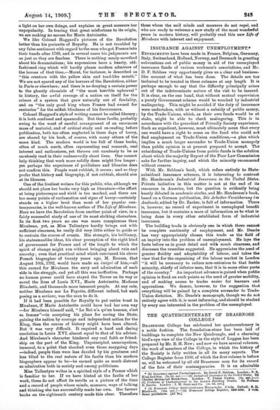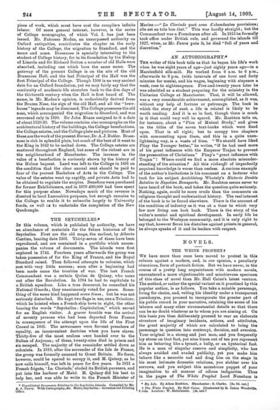THE QUATERCENTENARY OF BRASENOSE COLLEGE.t BRASENOSE College has celebrated her
quaterc,entenary in a noble fashion. The foundation-stone has been laid of buildings to complete the New Quadrangle, and a charming bird's-eye view of the College in the style of Loggan has been prepared by Mr. E. H. New; and now we have several volumes, the work of members of the College, in which the history of the Society is fully written in all its many aspects. Tbe College Register from 1509, of which the first volume is before us, will be welcomed by all old Brasenose men for its record of the fate of their contemporaries. It is an admirable
" (1) Insurance against Unemployment. By David F. Schloss. London : P. S. King and Son. [38.6d. net.]—(5) Industrial Insurance in the United States. By Charles Richmond Henderson. London : T. Fisher Unwin. (9s. (3) Problems of Unemployment in the London Building Trades. By North= B. Deane. London J. H. Dent and Co. [Is. 6d. net.] t (1) Brasenose College Quatercentenary Monographs. 2 vole. Oxford: B. Blackivell. [15s. neti—(Z) Brasenose Cottege Register, 16004909. 2 yob& Same publishers. [51 la.) piece of work, which must have cost the compilers infinite labour. Of more general interest, _however, is the series of College monographs, of which Vol. I. has just been issued. Mr. Falconer Madan, an unsurpassed authority on Oxford antiquities, contributes the chapter on the early history of the College, the migration to Stamford, and the name and arms. Brasenose is specially interesting to the student of College history, for in its foundation by the Bishop of Lincoln and Sir Richard Sutton a number of old Halls were absorbed, including one which bore the same name. The gateway of the . present College is on the site of the old Brasenose Hall, and the last Principal of the Hall was the first Principal of the College. Though 1509 is no very ancient date for an Oxford foundation, yet we may fairly say that the continuity of academic life stretches back to the dim days of the thirteenth century when the Hall is first heard of. The name, in Mr. 31adan's opinion, is undoubtedly derived from the Braun Nose, the sign of the old Hall, and all the "brew- house" legends may be dismissed. The College possesses the old nose, which accompanied the migration to Stamford, and was recovered only in 1890. Sir John Evans assigned to it a date of about 1120-30. The volume contains also monographs on the architectural history of the buildings, the College benefactions, the College estates, and the College plate and pictures. Most of these are the work of the present Bursar, Dr. A. J. Butler. Brase- nose is rich in splendid plate, but much of the best of it went to the King in 1642 to be melted down. The College estates are scattered throughout England, but some of the richest are in the neighbourhood of Manchester. The increase in the value of a benefaction is curiously shown by the history of the Hulme bequest. Land was left to the College in 1691 on the condition that the clear annual rent should be paid to four of the poorest Bachelors of Arts in the College. The value of the estates went up rapidly, and private Acts had to be obtained to regulate the surplus. Benefices were purchased for former Exhibitioners, and in 1870 £80,000 had been spent for this purpose alone. Nowadays mach of the revenue is directed to local Lancashire purposes, but enough remains to the College to enable it to subscribe largely to University funds, as well as to undertake the completion of the New Quadrangle.







































 Previous page
Previous page